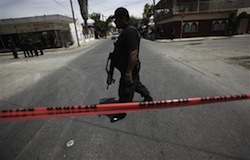Ciudad Juarez has dramatically reduced homicides in recent years, but the lack of clarity on how and why this has happened makes it difficult to replicate this success in Mexico’s current violence hotspots.
Since 2010, Mexican authorities have implemented a number of security reforms and social programs that facilitated Juarez’s transformation from a world murder capital into just another dangerous city near the US border, according to a recent report (pdf) by the International Crisis Group (ICG). Juarez registered 424 murders in 2014, giving the city a homicide rate that — while still above the national average — represents over a six-fold decrease from the murder rate in 2010.
The most far-reaching and ambitious of these reforms was Todos Somos Juarez (TSJ), implemented in 2010 by former President Felipe Calderon. During 2010 and 2011, the initiative poured over $380 million into “social programs designed to make communities, especially their young people, more resistant to violent crime,” according to the report. This included building new community centers, hospitals, and schools in low-income sectors of the city.
TSJ also established working groups, one of which is still active and is comprised of business associations, professional groups, the city’s human rights commission, and the local university. This “mesa de seguridad” meets twice a month and discusses plans to reduce crime in Juarez with local and federal authorities.
As documented by InSight Crime, Calderon also reduced the role of the military in Juarez and gave greater security responsibility to local police. The militarization of security forces in the city had led to a “dramatic increase in human rights abuse,” according to a study by the Washington Office on Latin America (WOLA) cited in the ICG report. However, the Juarez police chief who took over in March 2011 used highly aggressive tactics in combating crime, and was also accused of widespread human rights abuses.
When current President Enrique Peña Nieto took office in December 2012, he replaced TSJ with a national crime prevention program, known as PRONAPRED. This initiative has allocated roughly $6 million per year to Juarez since 2013, and these funds have gone to a myriad of social programs, according to the report.
Aside from murders, Juarez has achieved remarkable success in lowering other crime indicators since 2012. According to the report, there have been no reported kidnappings in Juarez since September 2013, and car thefts and burglaries have decreased significantly.
InSight Crime Analysis
According to many human rights observers, Mexico is justly criticized for the militarization of domestic security, which has been shown to result in increased human rights violations. Nevertheless, it should be noted that Calderon and Peña Nieto have shown some policy flexibility in how they have dealt with crime and violence in Juarez.
The military build-up during Mexico’s drug war occurred under Calderon’s watch and has only slightly subsided during Peña Nieto’s administration. But in Juarez at least, it appears both presidents have recognized that even in a city with war-like conditions, the deployment of soldiers trained for combat is an approach with serious drawbacks.
SEE ALSO: Mexico News and Profiles
Beyond that lesson, however, it is unclear what Juarez taught policy makers looking to replicate the same formula in other Mexican cities experiencing their own security crises. Investment in social programs in high-risk neighborhoods and the creation of citizen working groups likely facilitated Juarez’s dramatic decrease in murders over the past four years. But according to the ICG, “the impact of these efforts was never evaluated, largely wasting the opportunity to create innovative, sustainable programs, subject to outside review and evaluation.”
By neglecting to carry out impact evaluations on programs in Juarez, Mexico missed a golden opportunity to better understand which crime prevention interventions were effective, and which had a negligible effect on citizen security. Without these test samples, it will be much more difficult to determine how to apply effective policy prescriptions to other Mexican cities.
In that sense, Mexican authorities failed in Juarez, because the goal was to apply what they learned there to other cities wracked by violence. “The focus was Juarez, but the idea was to develop a collective impact approach that could be used throughout the country,” Enrique Betancourt, who led the National Centre for Crime Prevention and Citizen Participation under Calderon, told ICG.
SEE ALSO: Juarez after the War
Of course, there are any number of variables that factor into urban violence, from socio-economic issues, to criminal dynamics, to even the way in which authorities hunt drug lords. The confluence of many of these factors in Juarez — an economic upturn in the city, the end of a bloody war between the Sinaloa Cartel and the Juarez Cartel — might have made it difficult to assess the extent of the impact of government programs on crime reduction, even if rigorous, independent evaluations had been conducted.

